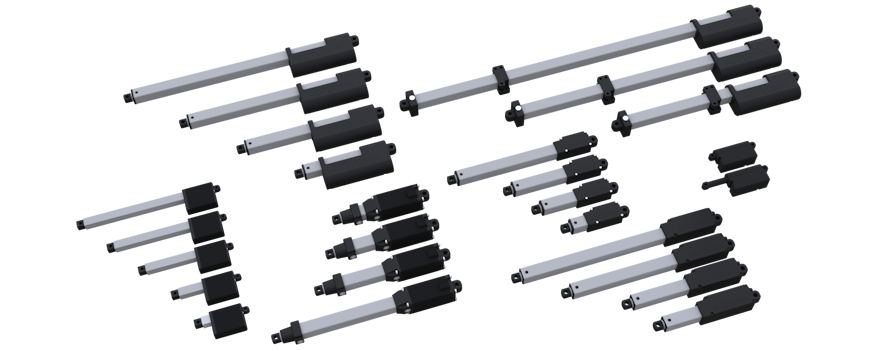Linear actuators come in hundreds of different varieties. 6V, 12V, 24V, different stroke lengths, different gear ratios and control options etc. There's a lot out there to choose from. It can still be difficult however to find a device that suits your specific needs. In a previous post we covered how to adjust linear actuator end limits. Today I'm going to show you four ways that you can adjust the speed of a linear actuator. Depending on your needs, skills and budget, you have some options.
Ways to Adjust the Speed of a Linear Actuator
Linear actuators come in many varieties with different voltages, stroke lengths, and control options. While this variety offers flexibility, finding the perfect actuator for your specific needs can still be challenging. Here are five methods to adjust the speed of a linear actuator:
1. Use an LAC Board or Motor Controller
A linear actuator control board gives you control over an actuator's speed, end-limits, and sensitivity. It also offers the option of controlling your actuator with one of five different input signals. An LAC board can only be used with Actuonix 'P' series micro linear actuators, as well as some large-scale actuators that have position feedback.
The board has a pot that is used to control the speed of the actuator. The maximum speed cannot be increased this way, but it makes it easy to slow an actuator down.
2. Use a Stepper Actuator
Using a stepper motor actuator is arguably the best way to adjust actuator speed. Stepper motors run in discrete steps and you drive the motor by changing the voltage to the motor inputs. That's why you need a special controller to drive them. By changing how fast you make these steps, you can precisely control how fast the motor/actuator runs. Another benefit is, changing the load won't impact the speed—it'll remain constant until you hit the stall force.
3. Adjust Input Voltage
A simple way to lower the speed of a linear actuator is to reduce the voltage at which you drive it. The speed of Actuonix actuators is approximately proportional to voltage. This means that if you were to drive one of our 12V actuators at 6V, the speed would be roughly half of what it is at 12V. This is approximate, but if you have access to an adjustable power supply, you can dial your voltage down to get the speed you need.
4. Buy an Actuator with Different Gearing
I realize this doesn't exactly qualify as "adjusting" actuator speed, but it's worth noting. Actuonix models come in several different gearing ratios to help accommodate the speed and force specs of your project.
For example, the three gearing ratios in our T16 linear track actuators offer speeds of 4.8mm/s, 18mm/s, and 46mm/s. Simply using a different gearing ratio can bring you much closer to the speed that you're trying to achieve.
If you can find a gearing ratio that works for you out of the box, that's the best-case scenario. If you need control over the speed, it's best to purchase an actuator that's a little faster than you need, as you can slow it down without damage. Trying to speed an actuator up by increasing the operating voltage will more than likely decrease the lifespan of the unit.
5. Ensure Your Signal Is Correct
If your actuator uses PWM or analog control (e.g., through an LAC board), ensure you're commanding the actuator to move at full speed.
Need Help Choosing the Correct Actuator?
Need help choosing the correct actuator for your project? The best place to start is with our Actuator Selector Tool. This tool will help you narrow down available options based on criteria that you select. If you still need more help, you can contact our sales team any time with questions.
Common Questions About Adjusting Linear Actuator Speed
What kind of controller is needed for stepper motor actuators?
Stepper motor actuators require a special controller to drive them. This controller adjusts the speed by changing the rate of discrete steps. We recommend the a href="https://www.actuonix.com/tic-t825">Tic T825 stepper motor driver for Actuonix stepper actuators.
How does reducing voltage affect actuator speed?
Reducing the voltage at which you drive the actuator will lower its speed. It will also change the performance characteristics of the device. The data sheet specifications can only be achieved when operating at the rated input voltage.
Can I make an actuator travel faster?
This is not recommended. There are several ways to reduce the speed of an actuator, but you should not attempt to increase the travel speed. Increasing the travel speed by using a higher input voltage than is recommended will void your product warranty and likely damage your actuator.
Browse Actuators From Actuonix Today
This article's overview of 'Ways to Adjust the Speed of a Linear Actuator' should help you find the right solution for your needs. View our collection of actuators by model or industry today. As a leading manufacturer and innovator in the micro motion marketplace, Actuonix services companies big and small in a number of industries including aerospace, medical, robotics, and more. Get in touch with us today to submit an order or to submit an inquiry.

